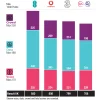Ofcom Grant Starlink an E Band Capacity Boost for UK Satellite Broadband

The telecoms regulator, Ofcom, has today granted “temporary authorisation” for SpaceX’s Starlink service to harness the E band (71-76GHz and 81-86GHz) frequencies for their mega constellation of compact ultrafast broadband satellites in Low Earth Orbit (LEO). The move will boost their backhaul data capacity at three gateway earth station sites.
The service currently has almost 8,800 satellites in orbit (c.5,200 are v2 / V2 Mini) – mostly at altitudes of c.500-600km – and they’ll add thousands more by the end of 2027. Residential customers in the UK usually pay from £75 a month, plus £299 for hardware (currently free for most areas) on the ‘Standard’ unlimited data plan (kit price may vary due to different offers), which promises UK latency times of 26-33ms, downloads of 116-277Mbps and uploads of 17-32Mbps. Cheaper and more restrictive options also exist for roaming users.
However, the operator’s growing network is known to have been dealing with some “capacity constraints on its UK operations“, which is why they recently requested (here) to use the E band spectrum at three of their existing gateway sites in Morn Hill (Hampshire), Wherstead (Suffolk) and Woodwalton (Cambridgeshire). But the E band has NOT previously been available in the UK for long term use by gateways, and Ofcom are still in the process of developing a policy to change that, hence the “temporary” approach to today’s change.
Advertisement
At present the E band is used by Fixed Services in the UK, while the adjacent band 86 – 92GHz is similarly allocated to, amongst other services, the Earth Exploration Satellite Service (EESS – passive) on a primary basis. The licences for those aren’t due to expire until 31st December 2028 and thus today’s decision will allow Starlink to harness the bands, albeit with some technical restrictions to support coexistence with existing services, a few years before the regulator introduces a more permeant change.
“Granting these temporary authorisations does not prejudge the outcome of our future consultation process on proposals for longer-term access to E band for satellite gateways and does not provide any assurance that Starlink will be able to access this spectrum at these sites, or on these terms, beyond the end date of the temporary licences.”
Despite the above statement, Ofcom has indicated that their goal with the E band is to make it available to satellite gateways on a more permeant basis in the future, so it’s likely that Starlink will continue to benefit from this access even after 2028. The move should “alleviate capacity constraints on [Starlink’s] UK operations, thereby improving the quality of internet services to its [broadband] customers,” added Ofcom.
The regulator separately still intends to make the Q/V bands (37.5–43.5GHz, 47.2–50.2GHz and 50.4–52.4GHz) available for satellite gateways in the future and they’re already consulting on that (here).
Otherwise, Starlink has previously outlined several benefits of obtaining access to E band for its UK gateways, including:
Advertisement
• Promoting competition, benefitting consumers and businesses without raising coexistence concerns;
• Improving latency and service quality;
• Providing redundancy for fibre-based broadband connections;
• Potentially reducing customer costs, by offering a more affordable way to increase capacity than deploying additional Ka-band gateways.
Mark is a professional technology writer, IT consultant and computer engineer from Dorset (England), he also founded ISPreview in 1999 and enjoys analysing the latest telecoms and broadband developments. Find me on X (Twitter), Mastodon, Facebook, BlueSky, Threads.net and Linkedin.
« Grain Start Building UK Full Fibre Broadband Network in Gainsborough UPDATE























































Privacy Notice: Please note that news comments are anonymous, which means that we do NOT require you to enter any real personal details to post a message and display names can be almost anything you like (provided they do not contain offensive language or impersonate a real person's legal name). By clicking to submit a post you agree to storing your entries for comment content, display name, IP and email in our database, for as long as the post remains live.
Only the submitted name and comment will be displayed in public, while the rest will be kept private (we will never share this outside of ISPreview, regardless of whether the data is real or fake). This comment system uses submitted IP, email and website address data to spot abuse and spammers. All data is transferred via an encrypted (https secure) session.